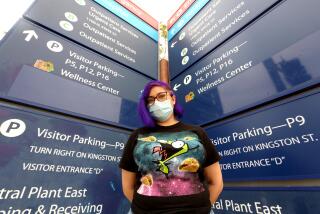Visits to Private Hospitals Jump as Cuts Loom : Health care: Emergency rooms see an 11% increase in patients as county prepares to close public clinics.
- Share via
Patient traffic in private hospital emergency rooms across Los Angeles County rose 11% during the week ending Sept. 2, an increase that hospital officials attribute to a decision by the county to stop accepting new patients at its public clinics.
The jump in emergency room visits was reported Friday by the Healthcare Assn. of Southern California, which tracked patients arriving at 36 emergency rooms in all sections of the county.
Private hospitals fear that their emergency rooms will be inundated with low-income patients as the result of the county’s plan to close six comprehensive health centers, 28 neighborhood clinics and most hospital outpatient units Oct. 1 to help bridge a massive budget shortfall.
The association survey compared emergency room visits between Aug. 27 and Sept. 2 and those recorded during the same period in 1994. The county began turning away new clinic patients Sept. 1, but officials had previously posted notices at clinics warning clients that they would have to seek medical care elsewhere. “The problems in emergency rooms haven’t gotten overwhelming yet, but this is a bigger change than we expected in one week,” said David Langness, a spokesman for the association. “We were frankly surprised at how much a difference a week makes.”
The survey showed that the number of patients who arrived at emergency rooms and then left without treatment rose 38% during the week, a statistic that Langness called a “frustration meter.”
“That is a measure of lines,” he said. “If you go to an emergency room and get in right away, you don’t leave. If you sit an hour, a few patients will leave; if you sit there four hours, a whole bunch will leave.”
The emergency rooms saw 16,045 patients during the week, compared with 14,233 in 1994. There were 595 patients who left without being seen, compared with 368 in 1994.
*
“We think it is a little early to draw too many conclusions,” said Toby Staheli, a spokeswoman for the Department of Health Services. “It’s only a week, and its the week before the policy took effect. I think we will find a better measure of the impact of the policy later on.”
Meanwhile Friday, county officials said they will accept more transfers of seriously ill patients from private hospitals.
County hospitals last week began refusing transfers of most non-emergency patients, with officials saying they needed time to reorganize medical staffs that would be devastated by the scheduled layoff of 5,000 workers because of the county’s budget crisis.
But private hospitals, facing higher costs, charged that patients needing specialized care available at county facilities also were being turned away and threatened to file a complaint with federal regulators.
In a Sept. 5 memo to private hospitals, county Health Services Director Robert C. Gates said that besides accepting transfers of patients with traumatic injuries, burns and neurological problems, the county will take those needing “highly specialized services,” such as newborn infants requiring intensive care.
County officials said the move was not a policy change, but private hospital executives proclaimed a victory.
“This new policy certainly opens the door to more transfers than the county originally wanted to take, and it helps stabilize some of the chaos in both the private and public sectors,” Langness said.
Langness’ group had threatened to complain to the federal Health Care Financing Administration, which investigates possible violations of federal laws that prohibit hospitals from denying care to seriously ill people. Hospitals that “dump” such patients face loss of their certification to receive Medicaid and Medicare reimbursements--a major funding source--as well as $50,000-per-violation fines.
Virginia Hastings, director of the county’s Emergency Medical Services agency, said Gates’ memo was intended only to clarify the county’s position. She said Gates’ Aug. 14 notice announcing the limits was not “real clear” about what patients the county would still take.
Hastings denied that the county policy violates anti-dumping laws, adding that it was ironic for private hospitals--which each year ship thousands of non-paying patients to the county as soon as they are stable--to be attacking the county for rejecting them.
In a Sept. 1 letter to the health care association, Gates noted that private hospitals usually transfer uninsured patients for financial, not medical, reasons.
More to Read
Sign up for Essential California
The most important California stories and recommendations in your inbox every morning.
You may occasionally receive promotional content from the Los Angeles Times.













